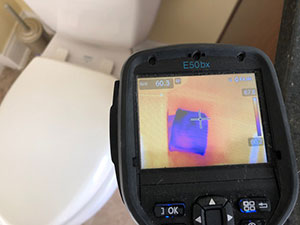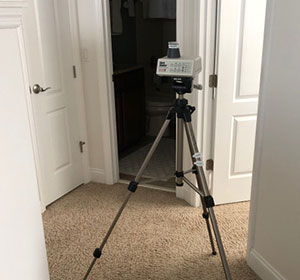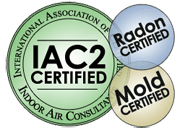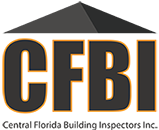Central Florida Mold Services
CFBI is proud to offer various moisture inspection services, mold testing & indoor air quality services to meet your needs. These services are typically performed for someone that thinks they may have a moisture or mold problem, has visible mold growth, can smell “musty” odors or who has had a previous water leak.
We also perform real estate transaction moisture inspections and mold testing when someone buys or sells a house. The purpose of this service is to discover mold and moisture issues BEFORE you purchase the property so you can make a better-informed decision.
The State of Florida has licensing in place for home inspectors and mold-related service professionals (mold inspectors and mold remediation contractors). When performing mold inspections and mold testing, there are some distinctions to be aware of related to our abilities in CFBI vs. a specialized mold assessment or remediation company:
A home inspector is allowed to:
- Perform moisture inspections
- Look for obvious signs of water intrusion & mold growth
- Collect mold samples
- Make recommendations for the need for qualified mold professionals
A mold assessor is needed when:
- There is over 10 sq. ft. of mold growth visible & an assessment is needed
- A remediation protocol is required
- For post remediation verification testing
- Providing guidance on remediation plans and procedures
If you feel you need a mold assessor, please visit our sister company, Elite Mold Services, for more information and pricing. Otherwise, to better understand CFBI’s services, we have listed them below:
What is a Visual Moisture Inspection?
A moisture inspection includes a visual evaluation of the entire property for obvious mold/fungal growth or other indicators of hidden mold problems. This also includes a moisture inspection with our radio-wave moisture meters in all areas that are prone to high moisture along with any areas of obvious moisture staining. We will check inside the HVAC system & ductwork for microbial growth. Our Thermal Imaging Camera will be implemented in our inspection process to help find active moisture that is not visible to the naked eye which in turn will help find mold.
Based on the inspection and if any visible mold or other “red-flag” areas are found, we then can make suggestions to collect sampling or a recommendation for a mold remediation (abatement). The State of Florida has licensing in place for remediation so for projects addressing over 10 sq. ft. of mold growth, a licensed professional would be required.

Mold Testing & Indoor Air Quality Sampling. What is it and how is it done?
Air Quality Testing & Mold Spore Sampling:
This is an extremely valuable type of mold test that will let you know what you are breathing inside a property. We collect air samples from within the home or building and everything in the air gets impacted onto the spore trap cassette. An outside air sample is always collected at the same time to evaluate the “normal” molds found around the property and this is used as a baseline for comparison.
These spore trap cassettes are then sent to the lab for analysis. The report will show not only the types of mold but also the levels or quantity of mold in the air. These reports will be helpful to determine if mold remediation is necessary or if any further actions are required.
Here at CFBI, we believe is using the best products in all we do. All air samples will be completed using Zefon spore trap cassettes (Air-O-Cell®) to ensure the most reliable results. The Air-O-Cell® is designed for the rapid collection of a wide range of airborne aerosols including mold spores, pollen, insect parts, skin cells, fibers and inorganic particulate.

Swab or Surface Sampling:
This is a test performed when the presence of mold is suspected or there is visible mold growth, and it needs to be identified or confirmed. Many of us can “spot” what we believe to be mold growth, however, having an independent microbiology lab confirm this could give you the upper hand in real estate negotiations. Also, we highly recommend using surface sampling to help identify or confirm possible sources of mold affecting the air. A good example of this is when there is visible mold in a HVAC system. A surface sample of this growth should be collected along with air sampling inside the home. Cross-referencing the type of mold found in the HVAC system will provide valuable details on the source of any elevated airborne mold spores.
The process of collection includes the use of a wetted swab or tape lift. The growth is collected off the surface and then sealed it in a specialized container. This will then be forwarded to an AIHA accredited laboratory for analysis. The report will include the mold genus name and the description of what common health effects are caused by it.

Carpet Sampling:
Behind-the-Wall Cavity Air Sampling:
This tool is used to sample the air spaces that could not be access without full demolition of the walls. During a mold inspection, if we find an area of hidden moisture we can drill a small 3/8″ hole and insert a special tube to sample the air in the cavity space. The sample will be sent to the lab for analysis and all spores present will be listed and their respective amounts. Due to the invasive nature of this test, approval will be required by the property owner first.

Odor (VOC) Sampling:

What’s included with every home inspection?
- A comprehensive visual inspection for moisture
- A detailed inspection for visible mold growth
- Use of infrared technology to find active moisture
- Use of radio-wave and pin moisture meters to spot check for moisture
- Photograph issues and write comments in report
- Suggestions for mold sampling
- Suggestions for corrective actions
- A comprehensive visual inspection for moisture
- A detailed inspection for visible mold growth
- Use of infrared technology to find active moisture
- Use of radio-wave and pin moisture meters to spot check for moisture
- Photograph issues and write comments in report
- Mold sampling included: Air, surface, wall cavity, etc.
- A certified mold report from microbiology laboratory
- More detailed suggestions for corrective actions based on test results
